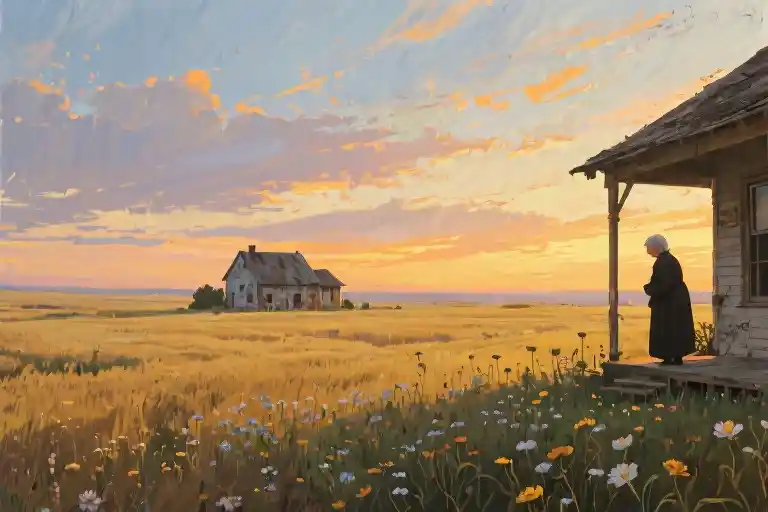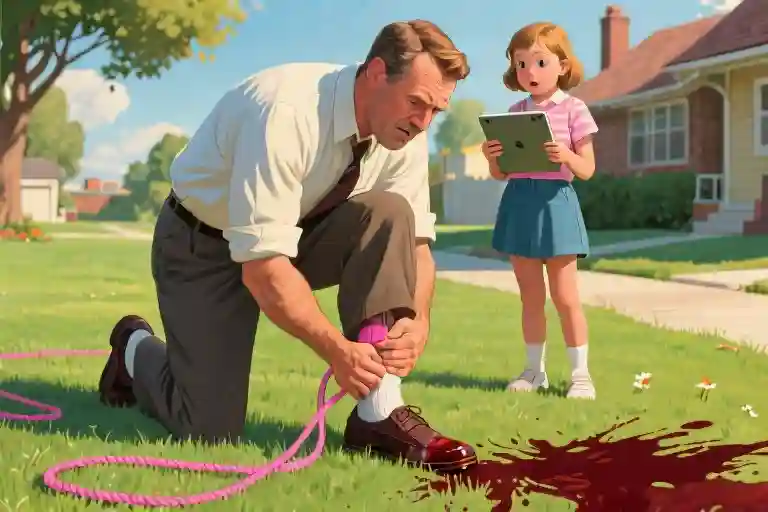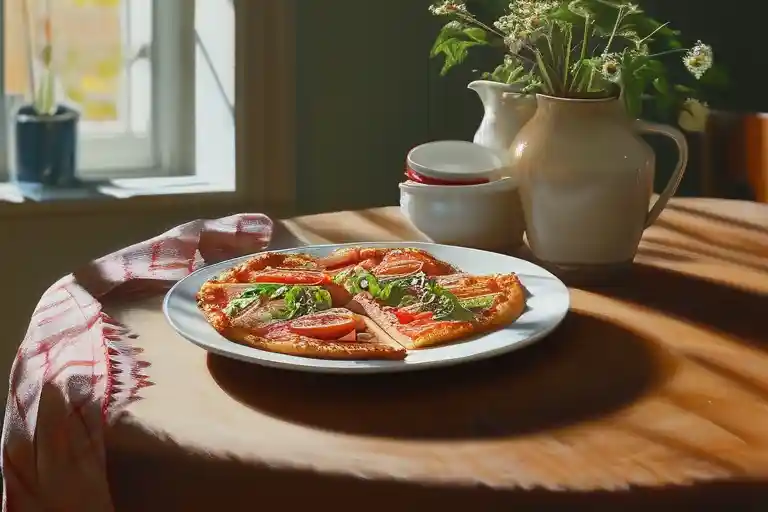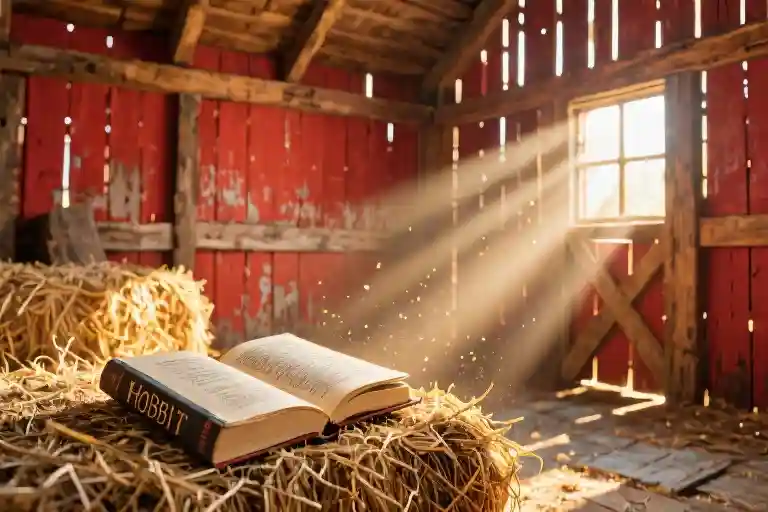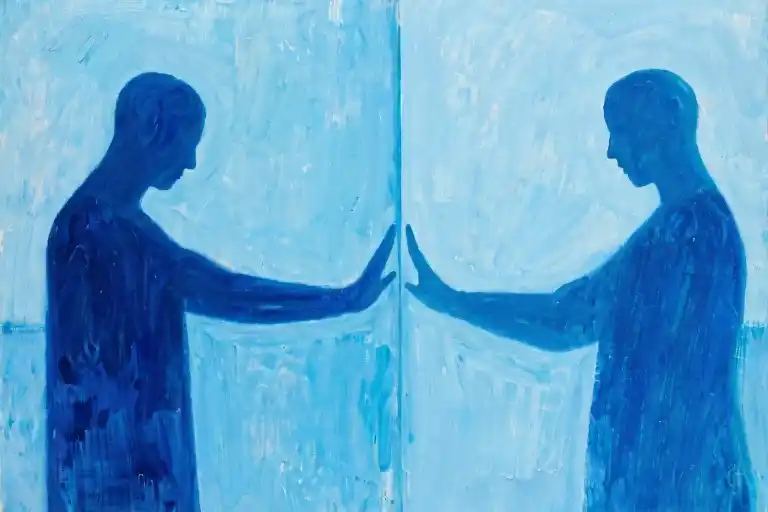The plains stretch endlessly around my grandmother’s house, a vast expanse of land that seems to swallow time itself. From her front porch, you can see the horizon curve gently against the sky, uninterrupted by mountains or trees—just flat, open space that goes on forever. It’s the kind of view that makes you feel small, yet strangely comforted by the simplicity of it all.
We were never close, my grandmother and I. Not because of the physical distance between her rural home and my city apartment, though that didn’t help. Not because of any family drama or unspoken grudges. The distance between us was something else entirely—a quiet choice, a lifetime of small decisions that added up to separate worlds. She lived deliberately alone, surrounded by chickens and a garden that demanded more attention than any human relationship ever could.
For years before I finally brought my children to meet her, our relationship existed through weekly phone calls. These conversations followed the same pattern: she talked about the drought affecting her tomatoes, the new litter of barn cats, the way the light changed over the plains in autumn. I listened, occasionally asking questions, trying to bridge the gap between her isolated existence and my crowded urban life. The strange thing was, despite sharing the same blood, we might as well have been strangers trying to build something meaningful when it was almost too late.
Then one day, between discussing the price of feed corn and the stubbornness of her old mule, she said something that changed everything: ‘You know, I’ve never seen the ocean.’ Her voice carried the same matter-of-fact tone she used when talking about the weather, but her eyes—those deep brown eyes that mirror my own—told a different story. The wrinkles around them, carved by decades of squinting across sun-baked fields, suddenly looked less like marks of age and more like paths leading to places she’d never been.
She gazed past me then, over the rooftops of neighboring farms, toward some imaginary coastline only she could see. In that moment, I understood something fundamental about generational gaps and family estrangement—how they’re not just about physical separation, but about the different worlds we inhabit within our own minds. My grandmother’s plains weren’t just geography; they were the boundaries of her experience, just as real and limiting as any fence or wall.
This revelation about the sea—her unfulfilled dream so casually mentioned—became the first true connection between us. It made me wonder what other longings she’d buried under years of routine, what other horizons she’d never reached for. More unsettlingly, it made me question what plains might be limiting my own vision, what oceans I might be failing to see.
As I watched her that day, a woman in her eighties who’d spent nearly a century on this flat land, I realized our phone calls had been like messages in bottles—small attempts at connection tossed across the vast ocean of our differences. And like any good message in a bottle, they contained both a cry for help and an invitation: Help me understand you. Let me show you my world.
The children played nearby, oblivious to this quiet epiphany, chasing grasshoppers through the dry summer grass. They would remember their great-grandmother differently than I did—not as the distant figure of my childhood, but as a real person with stories and secrets and unrealized dreams. Maybe that’s how family healing begins: not with dramatic confrontations, but with small revelations that ripple through generations, changing how we see each other across the distances of time and experience.
The Solitary Settler
My grandmother’s days unfold with the rhythm of the land, each movement measured against the endless horizon of the plains. At dawn, she moves through the mist to feed her chickens, their eager clucking the only conversation she welcomes. By midday, she tends to the vegetable patch with hands that know the soil better than any human touch. When evening comes, she sits on the weathered porch swing, watching the sun bleed into the flat earth—a ritual performed alone for decades.
Her isolation isn’t accidental. Neighbors from farms miles away occasionally stop by with fresh bread or town gossip, but their visits never last long. She listens politely, nods at appropriate intervals, then finds reasons to return to her solitude—a fence needing mending, a goat requiring attention. The few framed photographs in her house show younger versions of herself at community gatherings, but the smiles seem borrowed, the postures stiff. Somewhere along the years, she chose this quiet existence like one might choose a favorite chair—not for its comfort, but for its familiarity.
Meanwhile, my life pulses with urban urgency eight hundred miles northeast. Subway trains rattle beneath my apartment building while I video-conference with colleagues across time zones. My children’s schedules are color-coded on my phone: soccer practice, piano lessons, birthday parties with twenty screaming first-graders. The contrast between our worlds strikes me every Sunday morning when we talk—me balancing the phone against my shoulder as I pack lunchboxes, her voice crackling through the line about frost threatening her tomato plants.
This geographical distance mirrors something deeper than miles. Where I navigate crowded sidewalks and overflowing inboxes, she walks paths worn smooth by decades of solitary footsteps. My grandmother’s steadfastness in this isolated existence fascinates me—not as rejection of connection, but as a quiet rebellion against expectations. While society tells us to build networks and nurture relationships, she tends to her animals and watches the weather with the focus others reserve for social media feeds.
Yet for all her self-sufficiency, traces of something softer emerge in unexpected moments. She remembers each chicken by name, frets over an aging barn cat’s arthritis, leaves seed out for migratory birds even when money runs tight before harvest. These small kindnesses reveal what her words seldom do—that her choice of solitude isn’t absence of love, but love expressed differently. The plains didn’t make her this way; they simply gave her space to be herself without apology.
As I hang up our weekly call, the hum of my city life resumes—car horns, delivery trucks, a neighbor’s television through the wall. But for a few minutes, I’ve stood with her on that vast flatland where the wind carries no echoes, where a person can disappear into the horizon if they choose to. And I begin to understand that her version of connection might be measured not in words exchanged, but in the steadfastness of showing up—for the land, for the creatures in her care, and now, tentatively, for me.
The Strangers at Both Ends of the Line
The telephone cord stretched taut between us, a fragile tether connecting two worlds that might as well have been planets orbiting different suns. Every Sunday at 3 PM, like clockwork, the landline in my Brooklyn apartment would ring with that particular double-chime I’d come to associate with her. I’d perch on the kitchen stool, twisting the spiral cord around my finger while outside my window, subway trains screeched and neighbors shouted greetings in half a dozen languages.
Her voice always arrived slightly distorted by the distance, as if filtered through layers of prairie wind before reaching me. “The early frost took the tomatoes,” she’d announce without preamble, or “The Johnson boy’s dog had pups again.” For years, this became our ritual – she narrated the incremental rhythms of her isolated life on the plains, while I listened, staring at the grocery list stuck to my fridge with a magnet from Key West.
We weren’t so much having conversations as performing an odd, one-sided oral history. I’d murmur occasional acknowledgments (“That’s too bad about the tomatoes”), but mostly I just let her words wash over me, these fragments of a existence so alien to my urban reality. The generational gap between us yawned wider with each passing season – she spoke of canning preserves and mending fences; I thought about quarterly reports and preschool applications.
Then one October afternoon, as the light slanted golden through my west-facing windows, she broke our unspoken rules. Between updates about her arthritic collie and the new roof on the feed store, she said quietly, “You know, I’ve never seen the ocean.”
The admission landed like a stone in still water. Through the receiver, I heard the faint whistle of wind around her screen door, could almost see her sitting at that scarred kitchen table where she’d shelled peas and rolled pie crusts for sixty years. Her voice carried something I’d never heard before – not quite regret, but perhaps the ghost of curiosity about roads not taken.
“Not once?” I asked before I could stop myself, immediately feeling foolish. Of course not. The woman who measured distance in combine fuel consumption had likely never ventured beyond the grain belt.
“Oh, I meant to,” she continued, and I could picture her shrugging bony shoulders under that perpetual cardigan. “Back when your grandfather was alive, we talked about driving to Galveston. Then the heifers started calving early that spring…” Her sentence trailed off into static, the unsaid words hanging between us heavier than the spoken ones.
In that moment, I understood with sudden clarity how family estrangement isn’t always dramatic – sometimes it’s the slow accumulation of postponed dreams and unshared horizons. The emotional distance in families grows not from malice but from the daily choices that quietly define our lives. Her plains and my city weren’t just geographical locations but metaphors for how we’d each navigated our existence – hers rooted deep in familiar soil, mine constantly chasing the next gleaming skyline.
That phone call ended like all the others – with promises to “talk again next week” that felt both like a threat and a lifeline. But as I hung up, I noticed my hand trembling slightly. For the first time, I wondered if our weekly calls weren’t just her monologues, but bottles tossed into an ocean she’d never known, messages in a language neither of us fully understood how to speak.
Later, while slicing vegetables for dinner, I caught myself staring at the knife’s glint on the cutting board and seeing instead sunlight on waves I’d taken for granted. The kitchen smelled of onions and possibility. Somewhere eight hundred miles west, a woman who shared my cheekbones and my stubbornness was watching the same sunset over a very different horizon, both of us alone together in our separate worlds.
The Metaphor of Plains and Sea
Her confession lingered in the air between us, heavier than the prairie wind. “I’ve never seen the sea” wasn’t just a statement about geography—it was a generational epitaph. The vast plains that stretched beyond her kitchen window became both sanctuary and prison, shaping lives with invisible constraints.
The Geography of Limitation
That endless horizon I’d always found poetic suddenly revealed its duality. For grandmother’s generation, these flatlands represented stability during turbulent times—the Depression, wars, societal shifts. Their roots grew deep out of necessity, not choice. The soil demanded constant attention; crops wouldn’t wait for personal dreams. Distance wasn’t measured in miles but in responsibilities shouldered.
“People forget,” she once remarked while shelling peas, “we built our fences tall not to keep others out, but to remember where our duties lay.” The generational gap yawned widest here: where my cohort sees freedom in mobility, her generation found dignity in steadfastness.
Saltwater Longings
The sea became our unexpected bridge across decades. During subsequent calls, I’d describe coastal trips—the shock of cold Pacific waves, the briny scent of Eastern seaboard harbors. Her questions surprised me with their specificity: “Does it really stretch beyond sight? Do the waves sound like wind through wheat?” Each answer etched new wrinkles of wonder beside those carved by time.
Psychologists call this emotional distance in families—when shared DNA doesn’t guarantee shared experience. Yet through these conversations, we discovered an unexpected kinship in yearning. Her unrealized coastal pilgrimage mirrored my own deferred dreams, just wrapped in different landscapes.
Inherited Horizons
Visiting with my children made the metaphor tactile. My city-raised daughter gaped at uninterrupted skyline: “Where does the earth end?” Meanwhile, grandmother’s hands—knobbed from decades of labor—trembled while tracing a child’s palm. The plains had taught her crops and seasons, but not necessarily how to connect across generations.
That afternoon, watching her teach the kids to identify cloud formations, I understood something profound about dealing with distant grandparents. The space between lives isn’t emptiness—it’s a conversational canvas. Every “I never…” from her lips became an invitation to say “Let me tell you…”
The Weight of Roots
Modern mobility makes her choices seem foreign. Why stay rooted when the world beckons? But her generation’s unfulfilled dreams often stemmed from different calculations—where leaving meant abandoning aging parents or risking the only livelihood you knew. The plains promised survival if not transcendence.
Now, when my son complains about spotty WiFi at her farm, I see the metaphor complete itself. His frustration with temporary disconnection mirrors her lifetime of choosing connection to land over connection to wider worlds. Neither is wrong—just products of their time’s possibilities.
Currents Beneath Stillness
Perhaps this is how we bridge generational gaps—not by pretending differences don’t exist, but by honoring what shaped them. Her plains taught resilience; my coasts taught reinvention. Both geographies leave their marks on the soul.
As we packed to leave, she pressed a jar of wild plum jam into my hands—tangible proof that even the most rooted life can bear sweet fruit. The kids chattered about next summer’s visit while she stood framed by that infinite horizon, still quietly wondering about oceans.
Apples and Feathers
The farmhouse smelled of woodsmoke and dried herbs when we arrived, my children tumbling out of the rental car like excited puppies. My grandmother stood on the porch, wiping her hands on an apron that had probably been older than me. Her eyes—those same brown eyes I’d inherited—darted between the children as if trying to decipher some foreign language written in their movements.
“They’re… louder than I expected,” she said finally, watching my daughter chase a speckled hen across the yard. A statement, not a complaint. Just an observation about this alien species called grandchildren.
I watched her watching them. Seventy years of living alone on this prairie had made her fluent in the silence of animals and crops, but children operated on a different frequency. When my son held up a half-rotten apple he’d found under a tree, her fingers twitched toward it instinctively before retreating to her sides. The motion reminded me of how she’d pause during our phone calls, words caught between generations like apples suspended mid-fall.
Later, I’d find that basket by the door—carefully filled with polished apples, each one buffed to a shine that reflected her nervous preparation. Next to it, a jar of chicken feathers tied with twine. Gifts that made perfect sense in her world but left my city kids bewildered. “What do we do with these?” my daughter whispered, holding a feather like it might dissolve.
The afternoon unfolded in these mismatched offerings. She showed them how to collect eggs without startling the hens, her rough hands guiding their small ones with unexpected gentleness. When my son scraped his knee, she produced a handkerchief (monogrammed, unused for decades) with the solemn ceremony of someone bestowing a family heirloom. The children didn’t understand the weight of these gestures, but I did. Each one was a sentence in a language she’d never had occasion to speak before.
As the sun dipped toward the horizon, painting the prairie in golds we’d never see from our apartment windows, I noticed my grandmother’s hand hovering near my daughter’s braid. Not touching, just measuring the distance. That space between what she knew and what she longed to know. The same space that had once held all her stories about drought-resistant crops and the migratory patterns of geese now held something new—the possibility of touch.
When my daughter unexpectedly leaned into that tentative hand, I saw my grandmother’s breath catch. A bridge built not by grand gestures, but by chicken feathers and scraped knees and the quiet bravery of reaching across generations.
The Horizon and the Sea
The afternoon sun stretched our shadows long across the untamed grass as my grandmother stood at the edge of her property, hands clasped behind her frayed cardigan. My children, oblivious to the weight of this moment, tugged at her apron strings with sunburned enthusiasm. “Grandma, what are you looking at?” my youngest asked, following her gaze toward the unbroken line where earth met sky.
She didn’t answer immediately. A lifetime of living on this plain had taught her the value of measured responses. The wind carried the scent of dry soil and the distant clucking of chickens as we waited. When she finally spoke, her voice held the quiet wonder I’d only ever heard when she described the sea from television documentaries. “Just… possibilities,” she said.
In that suspended moment, three generations stood united yet worlds apart—the children who’d never known life without instant video calls to oceanside grandparents, the woman who’d measured distances by crop cycles rather than airline miles, and me, straddling both realities like a human bridge. My daughter pressed a pebble into my grandmother’s palm, a treasure from our coastal hometown. The older woman examined it as if it might contain tidal secrets.
Later, as we packed our suitcases, I noticed she’d placed the stone on her windowsill beside a framed photo of my father as a boy. The composition struck me—the frozen past and the fragment of an unexplored present, separated by decades yet sharing the same square foot of space. That’s when I understood our visits weren’t about bridging the generational gap in one triumphant leap, but about leaving small doorways ajar for curiosity to wander through.
Driving away, I watched her figure grow smaller in the rearview mirror until she became just another vertical line in the horizontal landscape. My son broke the silence from the backseat: “Do you think Grandma will ever visit the sea?” The question lingered like dust motes in golden hour light.
Perhaps we’re all standing on some version of that plain, I realized—peering toward horizons we may never reach, while treasures rest unnoticed at our feet. The true inheritance wasn’t in the stories she’d shared, but in the silent spaces between them where we’d planted our own meanings. And maybe that’s enough: to be reminded that even in life’s flat expanses, there are always currents running beneath the surface, connecting what seems separate.
Have you ever found unexpected connection across emotional distance in your family? Sometimes the most profound bridges are built one pebble at a time.

